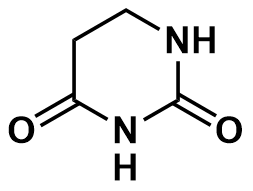Dihydrouracil Analysis Service
- Qualitative analysis of the metabolites of dihydrouracil
- Quantitative analysis of dihydrouracil content
- Provide basis for pharmacological studies and drug development
- Animal tissue ≥ 100 mg
- Plant tissue ≥ 200 mg
- Serum/ Plasma ≥ 200 μL
- Urine ≥ 2 mL
Dihydrouracil is a reduced derivative of uracil, a pyrimidine base that is a key component of RNA. Its structure consists of a uracil core where the double bond between the carbons at positions 5 and 6 has been reduced, resulting in a dihydropyrimidine ring. This compound is primarily known for its role in the catabolic pathway of pyrimidine metabolism, where it is formed from uracil by the action of the enzyme dihydropyrimidine dehydrogenase (DPD), which catalyzes the first and rate-limiting step of uracil degradation.
Dihydrouracil is commonly used in research to study pyrimidine metabolism, particularly in relation to the breakdown and recycling of nucleotides. Although dihydrouracil itself is not widely used as a therapeutic agent, understanding its formation and degradation is crucial for developing strategies to manage disorders associated with pyrimidine metabolism, such as certain types of cancer or genetic disorders like dihydropyrimidine dehydrogenase deficiency. It is frequently measured in clinical studies to assess the activity of pyrimidine catabolic enzymes, which is relevant in pharmacogenetic research, particularly concerning the metabolism of chemotherapeutic agents such as 5-fluorouracil.

Figure 1. The Structure of Dihydrouracil
At MtoZ Biolabs, we offer a comprehensive Dihydrouracil Analysis Service, leveraging our state-of-the-art liquid chromatography-mass spectrometry (LC-MS) platform and our skilled team of metabolomics experts. We ensure the highest sensitivity and accuracy in our dihydrouracil analysis.
Analysis Workflow
Service Advantages
1. Continuously refined protocols and cutting-edge analytical tools
2. Expert experimental planning
3. Rapid processing times
4. Exceptional precision, selectivity, and sensitivity
Applications
Sample Submission Requirements
1. Sample Types
Serum, plasma, urine, tissues and other biological samples. Each sample should be accompanied by at least 3 materials under the same condition.
2. Sample Volume
3. Sample Preservation
Samples should be stored at -80°C to maintain stability.
Note: Please provide detailed information on sample collection and handling.
Deliverables
1. Experimental Procedures
2. Relevant Liquid Chromatography and Mass Spectrometry Parameters
3. Detailed Information on Dihydrouracil
4. Raw Data
5. Custom Analysis Report
Our dihydrouracil analysis service is designed to support your research and product development efforts by delivering accurate and reliable results.
How to order?







